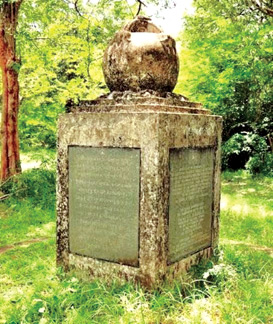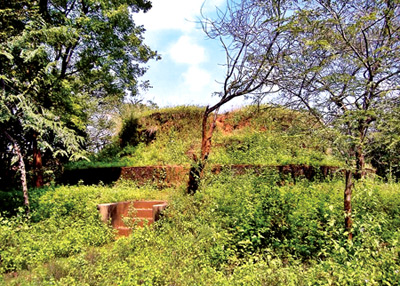|
Demala Maha Seya:
Bringing back Polonnaruwa's magnificent past
by Dhaneshi Yatawara
|

Monument established for first preservation project in 1982
|
The site preservation works of the 'Demala Maha Seya' in Polonnaruwa,
the next largest archaeological project of the Central Cultural Fund,
will begin on March 25. 'Demala Maha Seya' is the largest ever found
stupa in Sri Lanka so far, according to archaeologists.
Sri Lanka is rich with a diverse archaeological heritage.
Archaeological sites are not scarce in this tiny island.
Among them the most significant ones had been fascinating the world
over centuries. The 'Demala Maha Stupa' is one such monument which
carries many tales and speculations of archaeologists.
According to Dr. Roland Silva, highly acclaimed as an archaeological
expert and the founding Director General of the Central Cultural Fund,
the word 'Demala Maha Seya' means two storey (demahal) stupa. The Sri
Lankan chronicle on history, the Mahawamsa, states in 76 and 77
paragraphs that King Parakramabahu the great built this stupa using the
labour of Tamil (Damila) prisoners brought from India following the
victory over Chola Kingdom in South India and thus it became 'Demala
Maha' stupa. It is also believed that the king, as a sign of victory
wished to build this stupa to be visible to the South Indian Chola
Kingdom.
According to the written history this stupa has been built on the
instructions of the King Parakramabahu who reigned Sri Lanka from 1153
to 1186.
Though this is gigantic and believed to be an uncompleted stupa it is
recorded to be the largest ever built in Asia. Located in the
Polonnaruwa ancient city complex, the total height of the stupa is
approximately 625 feet.
The circumference of the stupa is more than 1,950 feet.
If King Parakramabahu had been able to complete this Stupa, this
would have been the largest Buddhist monument built by man.
|

The Demala Maha Seya |
First attempts to preserve the 'Demala Maha Seya' was in 1982
initiated by Dr. Roland Silva.
A Japanese bhikkhu Sojun Hatsusan extended his fundings for the
preservation works.
With the demise of the Buddhist monk the project halted and revamping
of the project did not happen until now. According to Dr. Roland Silva
if this stupa preservation works got completed it would be the largest
stupa in Asia.
This site is rarely visited by the casual pilgrim mainly due to the
road leading to the stupa being in a highly dilapidated state. The walk
is about 50m and worth every step. The flattened top of the stupa is
overgrown with huge trees and large enough to build a football ground.
This is the mountain you see to your right, covered with thick foliage
while travelling from Gal Vihare to the Thivanka pilgrimage or the Image
house. The climb is not that easy but worth the effort. With the earlier
efforts in 1982 the
The Central Cultural Fund had been able to preserve 35 feet of the
three 'pesa walau' of the stupa. And the earlier excavations done by the
Sri Lanka Cultural Triangle has revealed that the stupa has been build
around a mountain of quartz.
As the initial step of the site preservation process, research and
excavations will be started from the right side of the stupa. This stupa
is larger than the already preserved Jethawanarama, Abhayagiriya stupas.
The Central Cultural Fund plans to excavate and bring out one fourth of
this stupa by the end of this year. |

